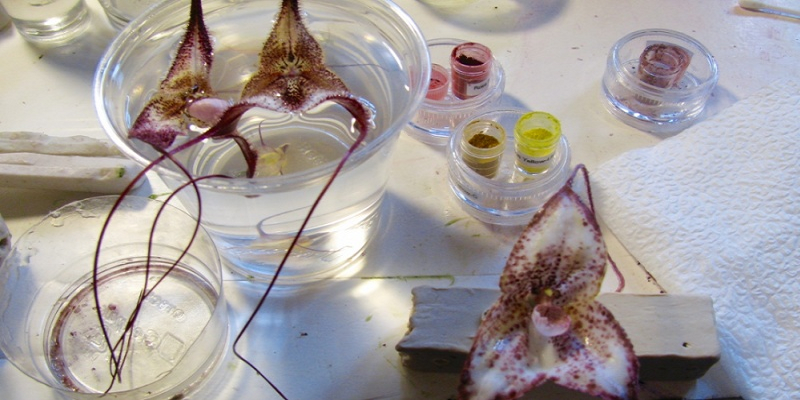
 Most garden centers, and some grocery stores, carry potted orchids that are advertised as being the easiest plant in the world to care for. All you have to do is drop a few ice cubes in the pot once a week; the company will even text or email you to remind you when it’s time to water your plant. It’s the perfect plant for the lazy or forgetful indoor gardener with a habit of killing plants; these particular cultivated orchids are apparently pretty difficult to kill.
Most garden centers, and some grocery stores, carry potted orchids that are advertised as being the easiest plant in the world to care for. All you have to do is drop a few ice cubes in the pot once a week; the company will even text or email you to remind you when it’s time to water your plant. It’s the perfect plant for the lazy or forgetful indoor gardener with a habit of killing plants; these particular cultivated orchids are apparently pretty difficult to kill.
While these grocery store orchids are about as simple as they come, orchids as a species are incredibly complex. There are over 27,000 known species of orchid in the world; no wonder there are numerous societies dedicated to the delicate flowers. They’re beautiful, colorful, and wonderfully fragranced – or are they? Some orchids, as a matter of fact, smell like human body odor, fungus, or other odious scents, so the next time you buy flowers for your date, give them a good sniff first.
As it turns out, orchids are much smarter than we give them credit for. One of the reasons they’ve become such a prolific plant is that many of them have developed a brilliantly sneaky way of attracting pollinators. Rather than luring insects in with sweet nectar, certain orchids will trick those insects by mimicking their favorite foods, or even potential mates or rivals, to get the bugs to come running. (Or flying.) The orchids’ disguises often take the form of certain smells, depending on the preferred scents of their favorite pollinators; for example, the orchid that smells like people prefers to be pollinated by mosquitoes.
Of course, once the insect lands on the orchid, it realizes it’s been had, and presumably flies off feeling stupid and annoyed. But the orchid’s mission has been accomplished, as the insect inadvertently carries pollen with it when it leaves – pollen that will be deposited on another orchid later, after the insect’s short memory causes it to fall for the exact same trick it fell for a few minutes ago.
It’s a remarkable con for a plant to pull off, and scientists are trying to figure out exactly how they do it — using 3D printing, of all things. It’s difficult to determine what part of a plant is attracting pollinators, and how – is it mimicking a scent, or an appearance, or both? Scientists have developed several tests using fake flowers made of anything from construction paper to cotton balls, to which different scents are applied. This allows them to observe which scents attract certain pollinators, but it doesn’t tell them much about how the insects respond to visual disguises – which is where 3D printing comes in.

Tobias Policha, a plant ecologist at the University of Oregon, led a recent study focused on a particular variety of orchid known as Dracula lafleuri, or the Dracula orchid. The orchid, which grows in Ecuador’s cloud forest, is a complex plant with large maroon-speckled petals and a single, oddly-shaped petal at its center. That petal, known as the labellum, looks remarkably like the mushrooms that grow nearby, which happen to be a favorite of fruit flies.
The appearance of the Dracula orchid is pretty much impossible to reproduce with paper, so Policha and his team enlisted Melinda Barnadas, a co-author on the study and a visual artist at the University of California San Diego. Barnadas is the co-owner of Magpie Studio, which creates models and illustrations for museums and researchers, and she used her expertise to scan the orchids and 3D print realistic silicone replicas of them. The team then went to work on the 3D models, applying different color patterns and scents and placing the replicas among the real orchids. They also created flowers from a mix of fake and real parts, to further confuse the flies.
The outcome of the study revealed that the mushroom-like labellum was indeed the part of the plant that attracted the flies. While this may not have been entirely surprising, the scientists did learn that both scent and appearance were equally important to the disguise; the insects weren’t fooled unless the petal both looked and smelled like a mushroom. (Perhaps flies are a little bit smarter than we thought.)
It’s a lot of work for what may seem to the layperson to be an insignificant discovery; why go to all the trouble? Understanding exactly how an orchid attracts an insect is actually an important step in understanding natural selection and evolution, which in turn plays a critical role in conservation.
“Mimicry is one of the best examples of natural selection that we have,” said Barbara “Bitty” Roy, a biology professor and co-author on the study. “How mimicry evolves is a big question in evolutionary biology. In this case, there are about 150 species of these orchids. How are they pollinated? What sorts of connections are there? It’s a case where these orchids plug into an entire endangered system. This work was done in the last unlogged watershed in western Ecuador, where cloud forests are disappearing at an alarming rate.”
We’ve seen 3D printing save the lives of individual humans and animals; now it seems that it could play a role in saving entire ecosystems. Think on that as you go drop your weekly ice cubes into your cultivated orchid – and be grateful that it doesn’t smell like fungus or worse. Discuss in the 3D Printed Orchid forum over at 3DPB.com.
If you're looking to get architectural 3D animation in the USA, our service provides an exceptional way to bring your architectural concepts to life through dynamic, immersive visuals. Through our platform, you can easily request high-quality 3D animations that showcase your designs in motion, offering a detailed view of your project from multiple angles and perspectives. Whether it's for a real estate development, a commercial building, or an urban planning project, our expert team ensures that every detail is captured in a visually compelling animation.
Through our website, you can seamlessly get architectural 3D animation tailored to your project’s specific needs. With our help, you can offer potential clients or investors an engaging experience that goes beyond static images. By integrating CGI animations with real-world settings, lighting, and textures, our team creates a lifelike experience that allows your audience to interact with your project as though it were already built. This service is perfect for presenting complex designs in a clear, visually attractive way that stands out in the competitive architectural market.




